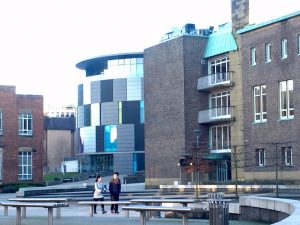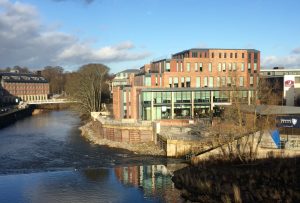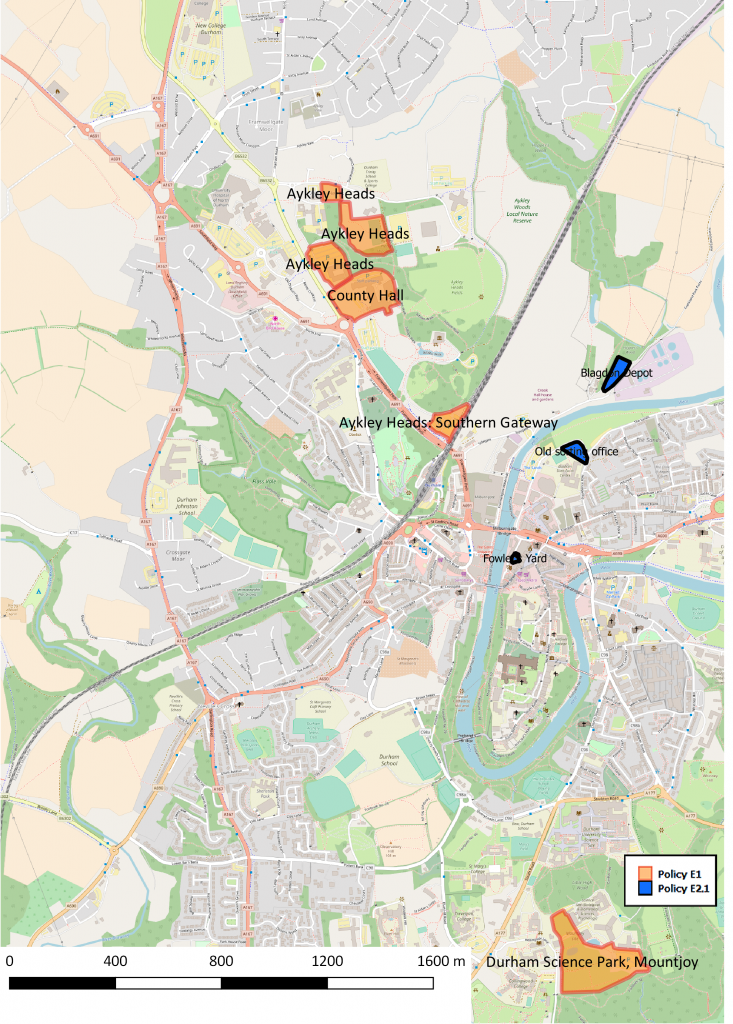Policy E2: Other Employment Sites
E2.1: Support will be given to the development of the following sites within or well-connected to the City centre, and to sites within district centres, for new office and business enterprises, including business incubators, start-up businesses and crafts, which fall within use classes A2 (Financial and Business services) and B1 (Business – Offices):
- Blagdon Depot, Frankland Lane; and
- Providence Row – old sorting office; and
- Fowler’s Yard.
E2.2: Support will be given to the development of windfall brownfield sites in Our Neighbourhood for mixed use office and business enterprises and also residential, including units for older people, families with children and young professionals.
4.113 Details of the sites (shown in Map 8) are as follows:
- Site E2.1.1 – the Blagdon Depot – is located in the Green Belt. Only proposals that meet the NPPF exceptions criteria for development in the Green Belt (NPPF para 89) would be acceptable. Retain mature vegetation around the site. The site is in Flood Risk Zone 2 and therefore appropriate infrastructure and design measures will be required and have to meet the requirements of heritage Policy H2.2, and promote sustainable development as set out in sustainability Policy S2. Development proposals for this site should undertake a site-specific flood risk assessment, a sequential test and an environmental assessment to include the impact on, and the protection of, green assets as set out in green infrastructure Policy G1.
- Site E2.1.2 – Providence Row old sorting office – the area for development is located outside the functional floodplain but is in Flood Risk Zone 3a where a high probability of flooding exists and therefore appropriate infrastructure and design measures will be required and have to meet the requirements of heritage Policy H2.2, and promote sustainable development as set out in sustainability Policy S2. Development proposals for this site should undertake a site-specific flood risk assessment, a sequential test and an environmental assessment to include the impact on, and the protection of, green assets as set out in green infrastructure Policy G1. Mature trees around the site should be retained.
- Site E2.1.3 – Fowler’s Yard – an area already thriving as craft and specialist shops.
4.114 In recent times, approvals have been given on most of the City’s large sites. Some of these have been contentious and remain unsupported by local people, specifically those which have been given for student accommodation which would now be refused under the new interim student accommodation policy (Durham County Council, 2016h). Where an opportunity arises from the renewal or lapsing of an application, modifications will need to be made to meet the requirements of our Neighbourhood Plan, particularly in respect of the new interim student accommodation policy and our housing Policies D2, D3, D4 and D5 in order to meet the shortfall in provision for affordable housing, and accommodation for the elderly, families with young children and young professionals. Design must be appropriate to the settings of the Durham City Conservation Area and the World Heritage Site (see heritage Policy H2.2) and promote sustainable development as set out in sustainability Policy S2.
4.115 As a general principle, new business development should be located on sites identified in economy policies E1 and E2. Some businesses, however, may be able to meet acceptable environmental standards, without either having a detrimental impact on the amenity of neighbouring occupiers of property or on the character and appearance of the area in which they are located. Such businesses can provide important employment opportunities within their locality and make use of buildings that may otherwise become redundant and/or derelict. This is of relevance in local centres, which can often provide an opportunity for a variety of small-scale business activities to take place.
4.116 Residents and visitors are increasingly seeking ‘experiences’ to add to their enjoyment of the City; therefore new commercial development in the City should include an external, flexible space wherever possible, which can be used for the well-being of their employees, and for staging community events.
Justification for Policies E1 and E2
 4.117 Businesses and residents have requested more land for commercial use: the sites allocated in Policies E1 and E2 are the only suitable land available in Our Neighbourhood which could be used for this purpose. To improve the economy of Durham City it is important to encourage new employment opportunities and to safeguard and assist expansion of existing businesses within the area. A good variety of serviced employment sites will help to attract new businesses and making available underused space as offices for established businesses will increase the employment opportunities for local people, attract new employees from outside the area, and encourage the retention of graduates from Durham University. New employment opportunities within the city will increase the numbers of people who use the City, and will also strengthen the relationship between local business and Durham University. This is recognised in the County Durham Plan Issues and Options consultation document (Durham County Council, 2016c, p.31, para 4.9).
4.117 Businesses and residents have requested more land for commercial use: the sites allocated in Policies E1 and E2 are the only suitable land available in Our Neighbourhood which could be used for this purpose. To improve the economy of Durham City it is important to encourage new employment opportunities and to safeguard and assist expansion of existing businesses within the area. A good variety of serviced employment sites will help to attract new businesses and making available underused space as offices for established businesses will increase the employment opportunities for local people, attract new employees from outside the area, and encourage the retention of graduates from Durham University. New employment opportunities within the city will increase the numbers of people who use the City, and will also strengthen the relationship between local business and Durham University. This is recognised in the County Durham Plan Issues and Options consultation document (Durham County Council, 2016c, p.31, para 4.9).
 4.118 In accordance with guidance in the NPPF (para. 111), commercial development will be directed to brownfield sites. In satisfying the sustainable design principles of our Neighbourhood Plan, new development will avoid unacceptable impacts on local, national and international designations and physical constraints such as flood risk and topography (Durham County Council, 2016c, p.18, para. 3.23 and 3.26). So far as flood risk is concerned, it would be highly desirable to have all brownfield employment sites located in Zone 1 (low probability of flooding). Whilst the majority of our sites meet that standard, there are three that fall within Zone 2 (medium probability of flooding) or Zone 3 (high probability of flooding). We are proposing to retain these three sites because they possess established use rights and new buildings can be designed such that occasional flooding of the ground floors is operationally acceptable.
4.118 In accordance with guidance in the NPPF (para. 111), commercial development will be directed to brownfield sites. In satisfying the sustainable design principles of our Neighbourhood Plan, new development will avoid unacceptable impacts on local, national and international designations and physical constraints such as flood risk and topography (Durham County Council, 2016c, p.18, para. 3.23 and 3.26). So far as flood risk is concerned, it would be highly desirable to have all brownfield employment sites located in Zone 1 (low probability of flooding). Whilst the majority of our sites meet that standard, there are three that fall within Zone 2 (medium probability of flooding) or Zone 3 (high probability of flooding). We are proposing to retain these three sites because they possess established use rights and new buildings can be designed such that occasional flooding of the ground floors is operationally acceptable.
Map 8: Map of Economic Designated Sites
Here is a zoomable map of the economic designated sites
Next section: Policy E3: Retail Development



1 Responses to Policy E2 2017